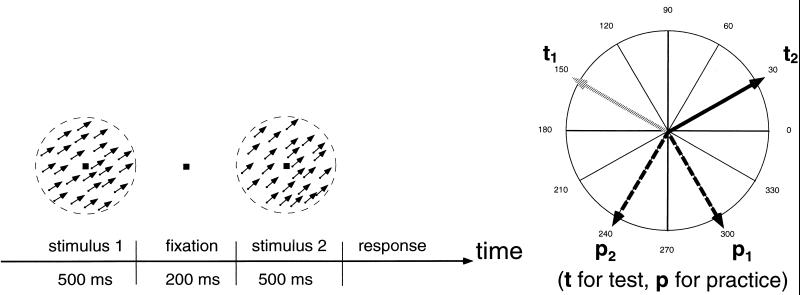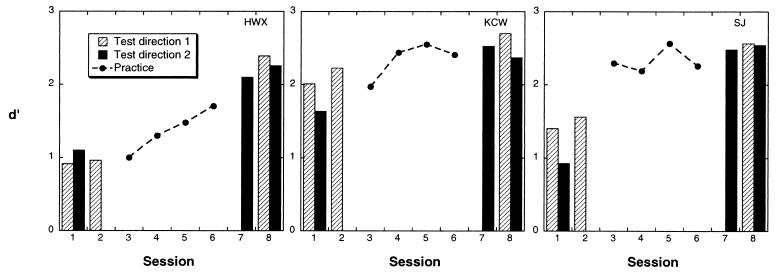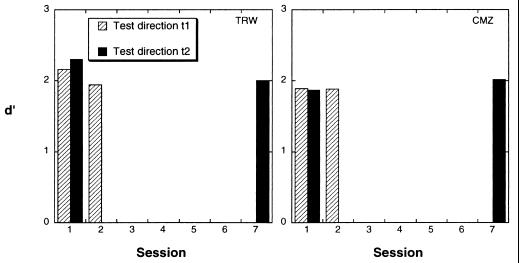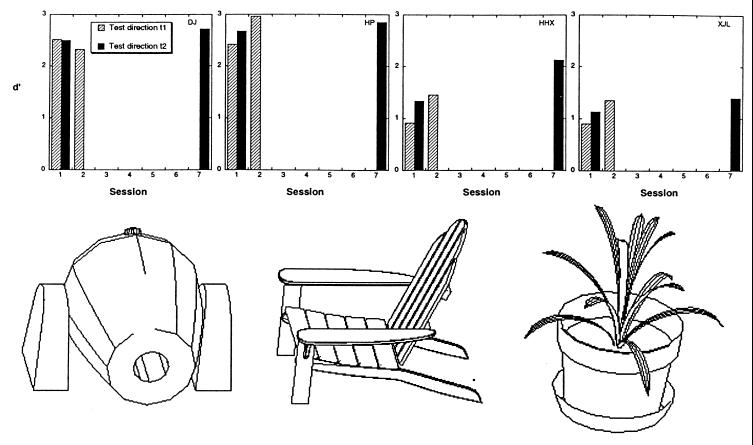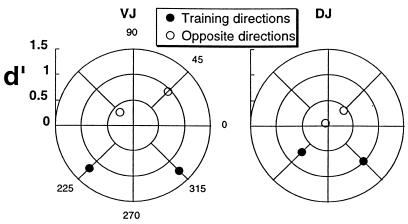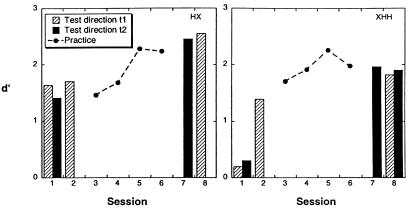Abstract
When human subjects discriminate motion directions of two visual stimuli, their discrimination improves with practice. This improved performance has been found to be specific to the practiced directions and does not transfer to new motion directions. Indeed, such stimulus-specific learning has become a trademark finding in almost all perceptual learning studies and has been used to infer the loci of learning in the brain. For example, learning in motion discrimination has been inferred to occur in the visual area MT (medial temporal cortex) of primates, where neurons are selectively tuned to motion directions. However, such motion discrimination task is extremely difficult, as is typical of most perceptual learning tasks. When the difficulty is moderately reduced, learning transfers to new motion directions. This result challenges the idea of using simple visual stimuli to infer the locus of learning in low-level visual processes and suggests that higher-level processing is essential even in “simple” perceptual learning tasks.
In a motion discrimination task, human subjects decide whether two sequentially presented motion stimuli move in the same or different directions (1). Each stimulus consists of 400 dots that are randomly and uniformly distributed in a circular aperture, which has an 8° diameter in visual angle. All the dots in one stimulus move in a single direction with a constant speed of 10°/sec. The motion directions of the two stimuli are either identical or different by 3°. The subjects practiced for a week with 700 trials per day, which lasted for 0.5 hr. There are two major findings in this task in particular, and in almost all perceptual learning tasks in general (1–7). (i) The subjects can learn, i.e., their performance gets better and better after repeated trials. (ii) This improvement, or learning, is highly specific to the practiced directions. For example, if the two possible motion directions are now orthogonal to the original ones, while everything else is kept the same, the subjects have to learn from scratch.
Note, however, that this task with a 3° directional difference is extremely difficult. Of course, the task is difficult for a reason: there should be enough room for the subjects to improve. The question is: can learning transfer to new directions if this directional difference is moderately larger (8, 9)? To address this question, I designed an experiment with a directional difference of 8° (Fig. 1). There are four primary directions in this design, each is defined as the average of the two possible motion directions in one experimental trial. Two of the primary directions are called the test directions, t1 and t2, and the other two the practice directions, p1 and p2. The experimental procedure was as follows.
Figure 1.
(Left) Schematic of one experimental trial. The circular aperture remains stationary while the dots inside it move in a single direction. The subject fixates at the central square from a viewing distance of 60 cm and decides if the motion directions of the two stimuli are the same or different. Feedback is provided after each trial. (Right) Experimental design. Session 1: the subjects’ baseline performance is measured in the two test directions, t1 and t2. Session 2: they practice in the test direction t1 and their performance is measured. Sessions 3–6: they then practice extensively in the two directions, p1 and p2. Session 7: they practice in the test direction t2, and the performance is measured. The assignment of the two test directions, t1 and t2, was counter-balanced across subjects.
Session 1: the baseline performance in the two test directions, t1 and t2, was measured, in an interleaved fashion (350 trials in each direction) to avoid any ordering effect.
Session 2: subjects’ performance in the test direction t1 was again measured, with 700 trials.
Sessions 3–6: subjects practiced in the primary directions, p1 and p2, in an interleaved fashion within each session, 350 trials in each primary direction.
Session 7: subjects’ performance in the test direction t2 was measured with 700 trials, the same as in the test direction t1.
Will the improvement in the second test direction, t2, from sessions 1 to 7, be greater than in the test direction t1, from sessions 1 to 2? Direction-specific learning predicts no difference, because each test direction is away from any of the three other directions for at least 90°, a distance too far for any transfer to occur. Therefore, no transfer should be expected from the directions t1, p1, and p2 to t2. As shown in Fig. 2, however, this transfer is substantial.
Figure 2.
Performance of three naive subjects (HWX, KCW, SJ). Session 1: baseline performance in the two test directions, each with 350 trials in an interleaved fashion. Session 2: performance in the test direction t1, 700 trials. Sessions 3–6: average performance in the two practice directions, p1 and p2, with 350 trials each in an interleaved fashion. Session 7: performance in the test direction t2. The improvement in the test direction t2 (session 1 → 7) is greater than in t1 (session 1 → 2) [t(2) = 5.93, P < 0.01, one-tailed test]. Session 8: performance in the two test directions, t1 and t2, half a year later.
However, before it can be concluded that perceptual learning in motion discrimination transfers to new motion directions, the following possible confounds must be addressed first.
Is the time difference between the two measurements in the directions t2 and t1 critical? Answer: no.
In the first control experiment, two fresh subjects did not practice in the directions p1 and p2, whereas the time difference between the measurements in directions t1 and t2 was kept the same as before. No transfer was found (Fig. 3). This result further suggests that the transfer was largely caused by the extensive practice in the directions p1 and p2, while the contribution to the transfer from the test direction t1 was not substantial.
Figure 3.
Performance of two naive control subjects (TRW, CMZ). Same as in Fig. 2 except that the subjects did no practice in directions p1 and p2. No difference was found between the improvements in the two test directions [t(1) < 1].
Does the practice have to be motion discrimination? Answer: yes.
In the second control experiment, the training of motion discrimination was replaced by a completely unrelated task. Instead of motion discrimination in a same-different task, it was now a same-different object matching task (10). Two static images were sequentially presented, each was followed immediately by a mask so that no apparent motion between the two images was possible. Subjects decided whether the two images were of the same object (with a possible viewpoint change) or different objects. The objects were computer graphics three-dimensional objects (Fig. 4). Although the test (motion discrimination, sessions 1, 2, and 7) and practice (object recognition, sessions 3–6) were unrelated, the context of the experiment was identical (same apparatus, same laboratory, …). I deliberately made the object recognition task easy; because an easy motion discrimination task transfers to new motion directions, it is best to use an easy control task to test whether it is the easiness per se that is responsible for the transfer. The average discrimination index d′ of the object matching was 3.98 (±0.38) [as opposed to 1.98 (±0.18) for motion discrimination], and each subject undertook 1,900 trials total. No transfer was found, therefore the practice has to be motion discrimination (Fig. 4).
Figure 4.
(Upper) Performance of four naive control subjects (DJ, HP, HHX, XJL). Same as in Fig. 2 except that instead of practicing the same-different motion discrimination task in directions p1 and p2, the subjects undertook a same-different object matching task. No difference was found between the improvements in the two test directions [(t(3) < 1]. (Lower) Example stimuli of the object matching task.
Is the transfer really caused by the easier motion discrimination task? Answer: yes.
In the third control experiment, the directional difference between the two possible motion directions was reduced to 3°, the same as in ref. 1. A subject first practiced in two primary training directions in an interleaved fashion. The subject then was tested in the two trained and two untrained primary directions. The performance in the trained directions was significantly better, i.e., learning was direction specific. Therefore, when the task is difficult, no transfer is found. I therefore have replicated the original experiment in ref. 1 (Fig. 5).
Figure 5.
Performance of two naive subjects (VJ, DJ), after practicing in the trained directions. The directional difference between the two possible motion directions in a trial was 3° instead of 8°. The subjects practiced in the two trained directions extensively (for at least five sessions), with 780 trials per session in an interleaved fashion. They then were tested in all directions, each with 64 trials in an interleaved fashion to avoid any ordering effect. Their performance in the trained directions was better than in the untrained ones [t(1) = 29.30, P < 0.01, one-tailed test]. Therefore, when the task is difficult (3°), learning does not transfer to novel directions.
Is the interleaving during the practice critical? Answer: no.
In a control experiment, trials in the practice directions p1 and p2 were blocked (350 trials in one direction followed by 350 trials in the other direction in each session) rather than interleaved. The same transfer result was obtained (Fig. 6). Therefore, the transfer from the practice directions p1 and p2 to the test direction t2 does not critically depend on interleaving the trials between the directions p1 and p2 (but see ref. 11 for transfer between the two interleaved directions).
Figure 6.
Performance of two naive control subjects (HX, XHH). Same as in Fig. 2 except that the practice in the directions of p1 and p2 was not interleaved but blocked. Both subjects showed transfer to the test direction t2 (Δd′ = 0.631 in the test direction t1, and Δd′ = 1.352 in t2). Session 8: performance in the test direction t2 the next day for subject HX; and in the two test directions, t1 and t2, 2 weeks later for subject XHH.
Acknowledgments
I thank David Jacobs, John Oliensis, and in particular, Pascal Mamassian, for many helpful discussions. This research was conducted in part when I was at the NEC Research Institute.
References
- 1.Ball K, Sekuler R. Science. 1982;218:697–698. doi: 10.1126/science.7134968. [DOI] [PubMed] [Google Scholar]
- 2.Ramachandran V S. Nature (London) 1976;262:382–384. doi: 10.1038/262382a0. [DOI] [PubMed] [Google Scholar]
- 3.Fiorentini A, Berardi N. Nature (London) 1980;287:43–44. doi: 10.1038/287043a0. [DOI] [PubMed] [Google Scholar]
- 4.Karni A, Sagi D. Proc Natl Acad Sci USA. 1991;88:4966–4970. doi: 10.1073/pnas.88.11.4966. [DOI] [PMC free article] [PubMed] [Google Scholar]
- 5.Poggio T, Fahle M, Edelman S. Science. 1992;256:1018–1021. doi: 10.1126/science.1589770. [DOI] [PubMed] [Google Scholar]
- 6.Gilbert C D. Proc Natl Acad Sci USA. 1994;91:1195–1197. doi: 10.1073/pnas.91.4.1195. [DOI] [PMC free article] [PubMed] [Google Scholar]
- 7.Karni A. Cognit Brain Res. 1996;5:39–48. doi: 10.1016/s0926-6410(96)00039-0. [DOI] [PubMed] [Google Scholar]
- 8.Liu Z. NEC Tech Report. Princeton, NJ: NEC Research Institute; 1995. [Google Scholar]
- 9.Ahissar M, Hochstein S. Nature (London) 1997;387:401–406. doi: 10.1038/387401a0. [DOI] [PubMed] [Google Scholar]
- 10.Liu Z. Spatial Vision. 1996;9:491–521. doi: 10.1163/156856896x00222. [DOI] [PubMed] [Google Scholar]
- 11.Liu Z, Vaina L. Cognit Brain Res. 1998;6:347–349. doi: 10.1016/s0926-6410(98)00008-1. [DOI] [PubMed] [Google Scholar]



